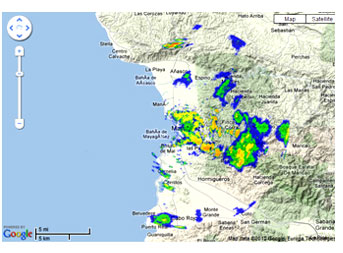First Student–Led Radar Test Bed OTG Node Installed at UPRM
The goal of the Student-Led Radar Test Bed (IP3) is to design, construct and deploy a low infrastructure network of weather radars for precipitation estimation in Western Puerto Rico. The radar network will help in filling the sensing gap in an area known to have poor WSR-88D (TJUA) coverage. To accomplish this goal, students have developed a new type of low power consumption (~180 W), short range (15 km), and low cost (~$30 k) Off-the-Grid (OTG) radar capable of operating completely independently of the existing prime-power and communication infrastructure. The radar was constructed based on the modification of an off-the-shelf marine radar with an expected 8-hour fully charged battery OTG operation time.
During the summer and fall of 2009, the OTG radar prototype was deployed at the CSU-CHILL facility and the OTG radar prototype calibration and validation was successfully performed. In January 2010 the OTG radar was successfully installed at the PR1 radar tower (temporarily, until its own tower is installed) on the rooftop of the Stefani Engineering Building at UPRM. Data is being collected for the purpose of validation and data quality analysis (special attention is given to ground clutter contamination and rainfall signal attenuation). A web application which displays radar data over Google maps was developed to provide access to the data in real-time. The rainfall event data collected with the OTG after the radar installation at UPRM is shown below. The radar has an estimated sensitivity of 12 dBZ at 15 km, and range and a mean cross-beam resolutions of 120 m and 500 m, respectively. The data was overlaid on a Google terrain map that will help with the identification of the clutter return from the mountains and will be used to create the clutter maps required to improve the data quality. A 20' tower will be installed at the Stefani Building rooftop to reduce the clutter return from nearby buildings.
Another OTG radar will be installed in May at a second location in Mayagüez for a 2-radar network configuration and to provide support to the NWS San Juan WFO during the Mayagüez Central American and Caribbean Summer Games (July 17th -August 1st), as requested by Mr. Israel Matos (Meteorologist in Charge) during a past student visit to the San Juan NWS WFO.

|